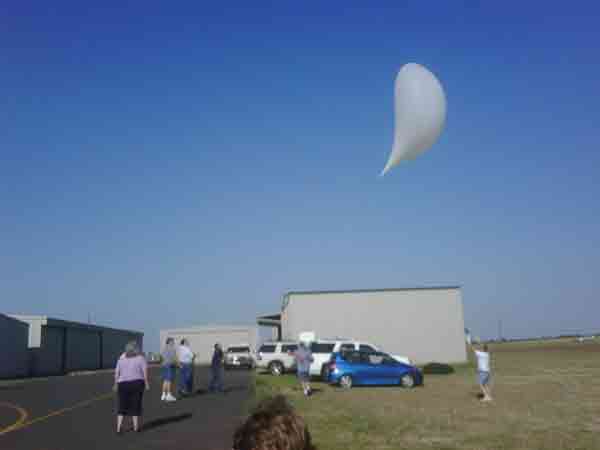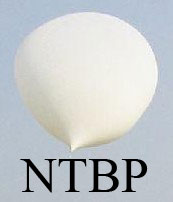NORTH TEXAS BALLOON PROJECT
FLIGHT 17
Summer 2009, August 8, Hillsboro, Texas
Flight Announcement
NTBP is a group of amateur (HAM) radio
operators from Fort Worth and Dallas and has launched balloons from Cleburne,
Clifton, and Hillsboro Airports since 1991. This is the first launch during this
last year and is funded by the amateur radio operators associated with the NTBP.
Please send an email to
webmaster@ntexbp.org
for further information or to make reports during or after the actual launch.

PRESS RELEASE
AMATEUR RADIO GROUP TO FLY BALLOON FLIGHT FROM
HILLSBORO TEXAS AIRPORT
The next mission number 17, named “Summer Time Blues”, to be held by the North
Texas Balloon Project (NTEXBP) is planned for launch about 8:30 am on August
8, 2009 from the municipal airport in Hillsboro, Texas, just south of Fort
Worth and Dallas. Back up date is August 15, 2009. Two payload packages
containing sensors and amateur radios will be carried to nearly 100,000 feet in
about 90 minutes by a helium balloon and return via parachute in about 50
minutes. Mobile recovery teams will use position reports from the onboard GPS
and APRS transmitter on 144.390 MHz and radio direction finding
techniques to recover the payloads.
Pre-launch activities will begin about 7:00 am with the HF Launch Net on 7260
+/- 5
kHz, LSB beginning around 8:00 am. A cross band repeater will be activated
soon after
launch. Uplink is 445.800 MHz and downlink is 147.560 MHz.
Handheld VHF radios
and scanners can receive the downlink easily. At the peak altitude ham radio
operators
from Texas, New Mexico, Oklahoma, Arkansas, Louisiana, and Kansas can contact
each other using the cross band repeater.
The radios used normally have a range of about 5 to 10 miles, but that range
will be extended to about 500 miles at the peak altitude. At the peak altitude,
the curvature of the earth is visible. Digital video is recorded for later
playback. APRS packets transmit the balloon's location about once a minute.
NTEXBP's Tommy Davis said, "In past operations we did the launches for fun and
the enjoyment of flight. It involves many different facets of amateur radio and
thus a project that many types of amateur radio operators can enjoy together.”
There is also an educational component utilized by scouting groups, because it
involves orienteering and can be counted toward several different merit badges,
as well as by teachers for science experiments. Davis said, “Area scout troops
are invited along with all that are interested.”
In the event of unfavorable weather or poor jet stream conditions, the launch
will occur at a later date. Be sure to check
www.ntexbp.org or
www.w5sjz.net and other Ham Radio forums and news sources for later
information.
The public is invited to come out to the Hillsboro Municipal Airport, located at
Exit 3 on
Interstate Highway 35W, to watch the launch.
North Texas Balloon Project is a group of amateur (HAM) radio operators from
Fort Worth and Dallas and has launched balloons from Cleburne, Clifton, and
Hillsboro airports since 1991. This is the first launch during this year and is
funded by the amateur radio operators associated with the North Texas Balloon
Project.
Operator’s and Technical Data to follow at
www.ntexbp.org or
www.w5sjz.net. Reports, questions, APRS and other data may be sent to NTEXBP
by emailing
webmaster@ntexbp.org .
Please forward to interested Hams and ham
communities. I would also appreciate any announcement that could be made on
local repeaters during allotted calls for announcements. Thanks as always.
Larry Westmoreland 73s K5PHD
PAYLOAD 1&2
Payload: Basic Package – APRS (part 1
of 2)
Purpose: Position reporting, recovery
support
Summary: Utilize Automatic Position
Reporting System (APRS) capabilities to allow reception by chase & recovery
teams with at least one Amateur Radio licensed operator & the required technical
equipment to track & recover the balloon launch packages
Technical Equipment Details:
-
Motorola OnCore 12-channel GPS receiver (common with voice beacon)
o
Provides location & date/time information as a serial data stream
to TT4
-
TinyTrakker4 (TT4)
o
Converts location & date/time information from GPS into tones that
can be transmitted through a standard voice radio
o
Also converts analog telemetry, such as battery supply voltage &
module temperature into tones that can be transmitted through a standard voice
radio
-
Yaesu VX-2R dual-band amateur transceiver that takes tones from TT4 &
transmits on 144.390MHz (standard APRS frequency in US) at ˝ watt of output
power
-
Diamond RH77CA dual-band antenna
-
Component power supplied by single-use lithium sulfate (LiSO4) batteries
o
3-cell pack supplies 9VDC to all electronics (individually
regulated down to 5VDC in each component) (common with voice beacon)
o
With an additional 2-cell tap which supplies 6VDC to APRS VX-2R
radio
Payload: Basic Package – Voice Beacon
(part 2 of 2)
Purpose: Position reporting, recovery
support, public monitoring
Summary: Utilize a BS2e single chip
microprocessor to read internal/external temperature sensors, to gather location
& date/time information from the GPS, & to control a text‑to‑speech module to
“speak” all of this information such that it can be received by anyone, with or
without an Amateur Radio license, without the need for any additional or
specialized technical equipment other than a simple receiver (scanner, radio,
etc.)
Technical Equipment Details:
-
Motorola Oncore 12-channel GPS receiver (common with APRS)
o
Provides location & date/time information as a serial data stream
to Parallax GPS module
-
Parallax BasicStamp BS2e
o
Acts as central controller for this capability
§
Generates Morse Code identification tones through the EMIC
text‑to‑speech module
§
Converts location & date/time information from Parallax GPS module
into commands to the EMIC text‑to‑speech module
§
Converts digital temperature data from internal/external
temperature sensors into commands to the EMIC text‑to‑speech module
§
Reports inside temperature, outside temperature, date, time,
number of GPS satellites being received, latitude, longitude, altitude, speed, &
heading
o
Programmed in PBASIC
-
Parallax GPS Module
o
Accepts location & date/time information from Motorola OnCore GPS
& provides command/status interface to BasicStamp BS2e
o
Includes an integral GPS receiver that is not utilized (we only
use the command/status interface it provides)
-
Dallas Semiconductor DS1620 Digital Temperature Sensors
(Internal/External)
o
Provides digital temperature data to BasicStamp BS2e
-
Parallax EMIC Text‑to‑Speech module
o
Accepts textual data from BasicStamp BS2e and converts it into
spoken audio that can be transmitted through a standard voice radio
-
Yaesu VX-2R dual-band amateur transceiver that takes Morse Code
identification tones and generated speech from EMIC
text‑to‑speech module &
transmits on 145.560MHz at ˝ watt of output power
-
Diamond RH77CA dual-band antenna
-
Component power supplied by single-use lithium sulfate (LiSO4) batteries
o
3-cell pack supplies 9VDC to all electronics (individually
regulated down to 5VDC in each component) (common with APRS)
o
Separate 2-cell pack supplies 6VDC to voice beacon VX-2R radio
§
If primary 9VDC battery pack fails, rendering all electronics
inoperative, then by design, the voice beacon radio will remain constantly keyed
(allowing direction finding by the chase & recovery teams to continue on this
constant carrier)
PAYLOAD 3
Ten Meter Beacon
The third payload of the flight is a ten meter beacon. This
beacon was built by ham operators employed at a local avionics shop. This home
brew transmitter and Byonics controller will be the basis of the beacon. It is
operating on a frequency 28.274 mhz. The antenna is a home brew
loop antenna with an swr of 1.2 to 1. The output of this transmitter is
approximately 400 milliwatts. This coupled with the high gain antenna, should be
heard world wide? Please report contact and we will happily qsl the event. Email
webmaster@ntexbp.org or
Flight Summary
Flight 17 is
finished and successful. It was troublesome and we had the loss of our parachute
and spreader. It is marked so we hope we will hear from its locator. It took us
three tries to get it off the ground. High winds and late data caused a later
than hoped for launch. The balloon parted the first time but was reeled back in
and reattached. The second try dropped the packages and the balloon went on its
own. The third launch with the second balloon did the trick. All packages
functioned as expected until near 90,000 feet. At that time we lost contact with
all packages. Ten minutes later some of the hunters heard the two meter beacon
much like we hear when it is on the ground. After a few minutes of hunting the
packages were recovered. They did not come down via parachute as planned and
there was no evidence of the chute or the spreader. We encourage any one with
reports to send them to us here via email.
Flight Audio
Furnished by Sam, K5KJ at
YouTube
Furnished by Andy Mans, N5LDI,
Here
Flight Data
Furnished by Ed Fore, AC5TI,
Here
Furnished by Bill Davis, KG5IE,
APRS.FI
Flight Pictures

|

